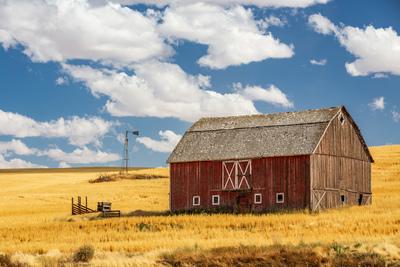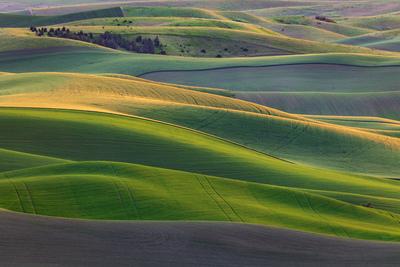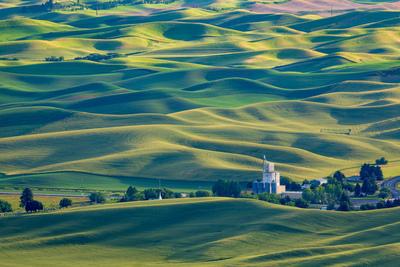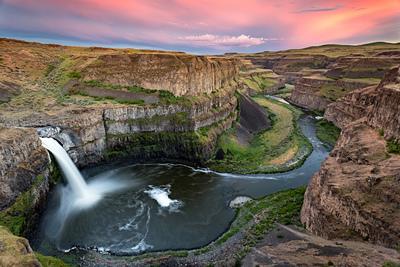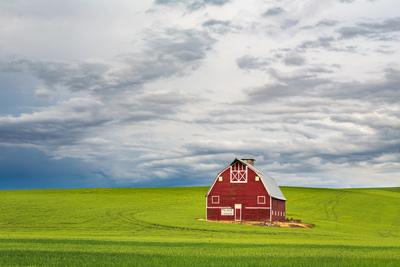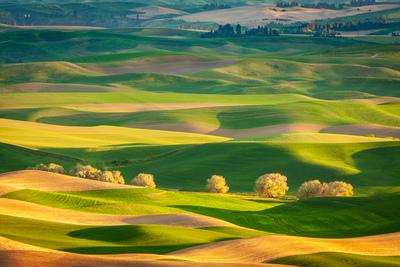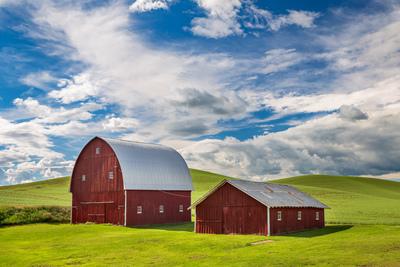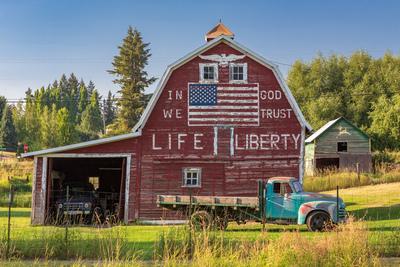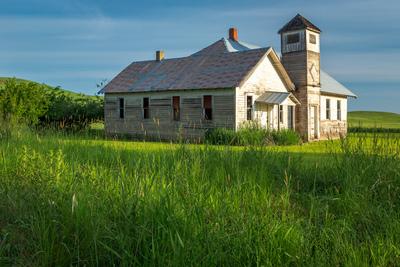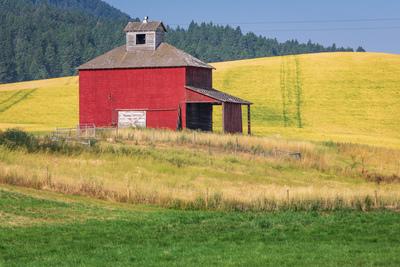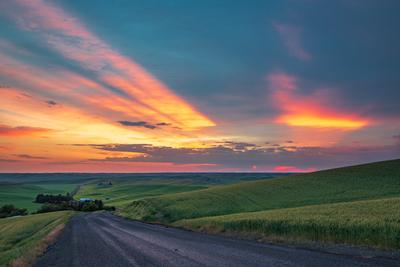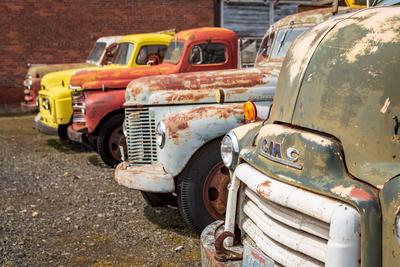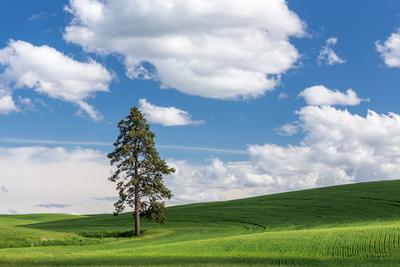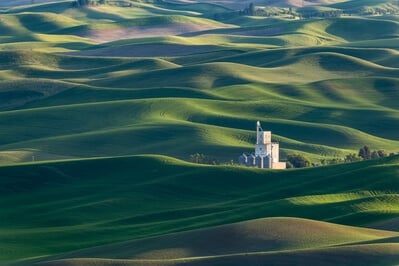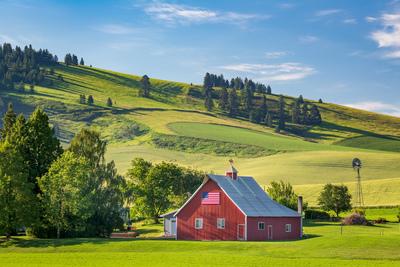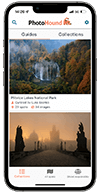The photography guide to
 Palouse
Palouse
Palouse photography guide
Our contributors have added 154 photo spots to this Palouse photo guide. Have you discovered an amazing new location in Palouse?
Introduction
Sometimes referred to as “America’s Tuscany,” the Palouse region of Washington and Idaho is an expanse of rolling hills occasionally cut by canyons and pierced by high buttes populated with isolated farms and small towns. The Palouse, covered with fields of wheat, alfalfa, chickpeas, and other crops, as well as classic barns, old trucks, abandoned farmsteads and prairie schoolhouses, and occasional lone trees, offers spectacular landscapes and classic shots of Americana.
In late spring and early summer, the hills are covered with every shade of green and the area is a favorite of landscape photographers. However, other than at a few favored locations, you will rarely see other photographers due to the sheer size of the region: the Palouse covers over 6,000 square miles.
The photographic experience is spectacular whenever you visit. Later in the summer, the hills turn golden and harvest season starts. Autumn brings its own color to the scattered aspens and cottonwood trees amongst the hills. And winter provides frosty fields of green sprouting winter wheat as well as occasional snow covered scenes.
There is no definitive definition of the area covered by the Palouse. Some define the region as small, the area only encompassing Washington’s Whitman County; others define it as covering much of southeast Washington and north-central Idaho as well as extending into northern Oregon. This guide covers the more moderate area extending north almost to Spokane, west to Palouse Falls, south past the Snake River, and some ten miles east into Idaho. The area is centered on Colfax, Washington, and all areas covered by the guide are within an hour and half drive of Colfax.
Most popular Palouse photo spots
Top Picks
Without a doubt, if there is only one stop you can make in the Palouse, head for Steptoe Butte. Steptoe rises about 1,000 feet above the surrounding landscape and there is no better place to view and photograph the rolling hills and fields of the Palouse, especially near sunrise and sunset, when the light rakes across the landscape. Near sunrise and sunset in late spring and early summer, you will find dozens or more other photographers sharing the view. Luckily, you will find plenty of room for everyone to set up a tripod.
If you want similar scenery, but prefer your photography without a crowd, I recommend visiting Skyline Drive on the Washington-Idaho border near the town of Farmington. While Skyline Drive only offers an approximately 180-degree view of the surrounding landscape, as compared to the 360-degree view at Steptoe Butte, I can almost guarantee you will be alone. In the half a dozen times I’ve photographed there, I’ve only ever seen one other person.
No trip to the Palouse would be complete without a visit to Uniontown, Washington, home to two highlights of the Palouse: the Dahmen Barn and Wagon Wheel Fence and the Palouse Country Barn. Located on the north end of Uniontown is the Dahmen Barn – a large, classic white barn with an attached silo. It is surrounded by a metal fence constructed of thousands of old wagon and tractor wheels. The property is now an artist cooperative, and the grounds are always open and very welcoming of photographers. And just south of town is the Palouse Country Barn – a classic red barn, proudly displaying a “Palouse Country” sign, set in the middle of a wheat field.
Colfax is near the center of the Palouse and forms a great “basecamp” for explorations of the area. One of the most photogenic barns in the region is just a short distance outside of town. The Heidenreich Dairy Barn is about a five minute drive from downtown Colfax. This large, red gothic-style barn is a photographer’s favorite due to a stylish and colorful old truck parked out in front of the barn. Another nearby highlight is the Manning-Rye Covered Bridge, located less than fifteen minutes northwest of Colfax. Here an old partially covered railroad bridge (converted for auto use to access a farm) extends over the Palouse River in a basalt-rimmed canyon. Aspens and cottonwoods grace the river banks near the bridge.
Perhaps the best shot of the river, however, will be at Palouse Falls State Park, located in the western portion of the Palouse. Here, the river drops 185 feet over a black basalt cliff into a deep canyon. Near the falls, the canyon walls are laced with green moss and plants, providing a colorful contrast to the desert-like conditions above the canyon walls.
All of the above described spots, except perhaps Skyline Drive, are popular with photographers. However, there are many more photogenic barns, lone trees, vistas, abandoned houses, old trucks, and more that you can photograph by yourself. You can easily spend a week in the Palouse photographing visiting a hundred different spots. Some of my lesser known favorite spots include the Tennessee Flats lone trees, a graceful pair of cottonwoods that can be photographed with Steptoe Butte in the background; the Cordelia Lutheran Church, a one-room white clapboard church with a two-hole (his and her) outhouse; the Almota Road trucks and barn, where a row of nine colored old trucks are lined up in front of a red barn; the Eriksen barn, an unusually colored baby-blue and brown barn; and the Filan Road grain elevator, an old wood-cribbed grain elevator located off the beaten path.
Travel
If not driving yourself into the Palouse, the nearest major airport is in Spokane, Washington, about an hour’s drive north of Colfax. If flying in, you will want to rent a car because when visiting the Palouse, you need your own transportation. There is limited public transportation between towns, but none to any of the spots in the guide outside of the towns.
When driving in the Palouse, be aware there are essentially four types of roads: highways, paved non-highways, all-season gravel roads, and dirt “summer-only” roads (usually open from mid-March to mid-November, though this can vary). Regular passenger cars can navigate all of these except for a few summer-only roads that could require a high-clearance vehicle. Additionally, the summer-only roads should be avoided if wet, where even 4-wheel drive vehicles can get mired in mud. Also in winter during and shortly after snow storms, the all-season gravel roads, and sometimes the highways as well, can become difficult to navigate due to snow accumulations and drifts. Whatever the season, an all-wheel drive SUV is probably the perfect vehicle for visiting the Palouse. Parking can sometimes be tight on the paved highways and roads, where sometimes there is little room on the shoulder. Parking is less of a concern on the gravel and dirt roads, where you can typically just pull over far enough to make sure there is room for another car to pass.
When traveling the backroads of the Palouse, be advised that the towns are few and far between. Many of the smaller towns don’t have restaurants or sometimes even stores. It’s best to start a day of photography with a full tank of gas as well as extra drinking water and snacks. Cell phone coverage is good along most the highways, but can be spotty elsewhere.
The best times to photograph most spots in the Palouse are during the golden hours. And though all seasons can be good for photography here, late spring and early summer are favored by most photographers. In mid-June, the sun rises before 5 a.m. and sets shortly before 9 p.m. Sixteen hours of daylight make for some very long days, especially if driving to or from a motel in Colfax or Pullman in order to be on site for sunrise and sunset. One strategy I use to support a full day of photography in June is to eat a simple breakfast in my room before heading out for the day, then returning to town in mid- to late morning, making lunch my main meal, and taking a nap until mid-afternoon. Leaving in the afternoon, I’ll stop and buy a sandwich to take along for later, photograph until sunset, and eat the sandwich while enjoying the view in the fading light at my final photo stop of the day. This itinerary works well since there are few, if any, restaurants open at 4 a.m. in the morning or 10 p.m. at night.
Another consideration if photographing in spring and early summer is to be aware of ticks. I suggest wearing long pants and, after walking in long grass, always checking your legs for ticks that might be hitching a ride. Light colored clothing is preferred so it is easier to see these small dark pests. When you get back to your lodging at night, be sure to take a careful look over your whole body for the pesky critters. If you do find a tick attached to your skin, the best way to remove one is with tweezers, grasping the tick as close to your skin as possible, and pulling straight upward with a steady pressure.
The people who live in the region are generally very friendly; however, with the increasing popularity of photography in the Palouse over the past several decades, some photographers and photography workshops have clashed with locals by trespassing. Nearly all the land in the Palouse is private property. Please do not enter barns and other buildings, even if they appear abandoned, without permission. Similarly, do not walk into farm fields, whether growing or not, without permission.
Links
Palouse Events
Accuweather - Palouse
Experience Washington
Visit Palouse
Explore more photo spots in United States
If you want to explore beyond Palouse, we have 1880 photo spots and 15 events that you can visit in United States.
Curated By
Joe Becker Curator
We hope you enjoy this guide to photographing Palouse - don't forget to share your images on PhotoHound and tag us on social media using hashtag #photohound
